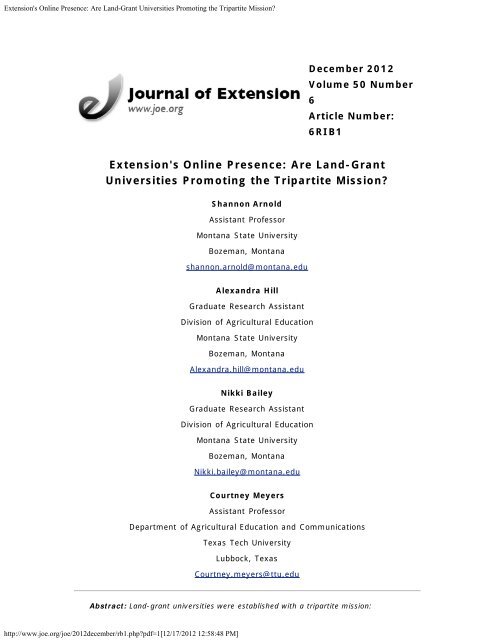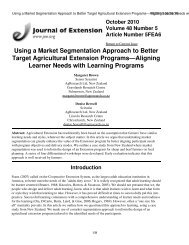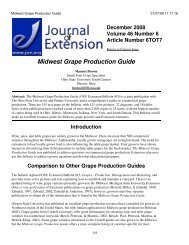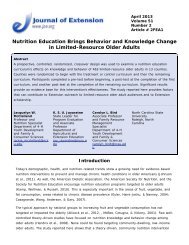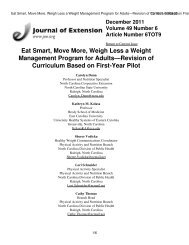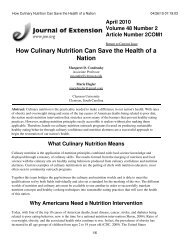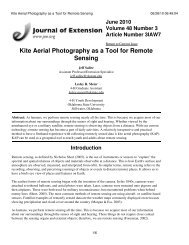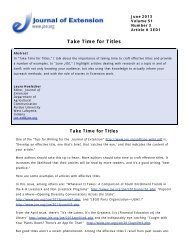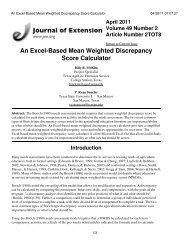Are Land-Grant Universities Promoting the Tripartite Mission?
Are Land-Grant Universities Promoting the Tripartite Mission?
Are Land-Grant Universities Promoting the Tripartite Mission?
Create successful ePaper yourself
Turn your PDF publications into a flip-book with our unique Google optimized e-Paper software.
Extension's Online Presence: <strong>Are</strong> <strong>Land</strong>-<strong>Grant</strong> <strong>Universities</strong> <strong>Promoting</strong> <strong>the</strong> <strong>Tripartite</strong> <strong>Mission</strong>?<br />
http://www.joe.org/joe/2012december/rb1.php?pdf=1[12/17/2012 12:58:48 PM]<br />
December 2012<br />
Volume 50 Number<br />
6<br />
Article Number:<br />
6RIB1<br />
Extension's Online Presence: <strong>Are</strong> <strong>Land</strong>-<strong>Grant</strong><br />
<strong>Universities</strong> <strong>Promoting</strong> <strong>the</strong> <strong>Tripartite</strong> <strong>Mission</strong>?<br />
Shannon Arnold<br />
Assistant Professor<br />
Montana State University<br />
Bozeman, Montana<br />
shannon.arnold@montana.edu<br />
Alexandra Hill<br />
Graduate Research Assistant<br />
Division of Agricultural Education<br />
Montana State University<br />
Bozeman, Montana<br />
Alexandra.hill@montana.edu<br />
Nikki Bailey<br />
Graduate Research Assistant<br />
Division of Agricultural Education<br />
Montana State University<br />
Bozeman, Montana<br />
Nikki.bailey@montana.edu<br />
Courtney Meyers<br />
Assistant Professor<br />
Department of Agricultural Education and Communications<br />
Texas Tech University<br />
Lubbock, Texas<br />
Courtney.meyers@ttu.edu<br />
Abstract: <strong>Land</strong>-grant universities were established with a tripartite mission:
Extension's Online Presence: <strong>Are</strong> <strong>Land</strong>-<strong>Grant</strong> <strong>Universities</strong> <strong>Promoting</strong> <strong>the</strong> <strong>Tripartite</strong> <strong>Mission</strong>?<br />
education, research, and outreach through <strong>the</strong> Cooperative Extension Service. The<br />
purpose of <strong>the</strong> study reported here was to evaluate <strong>the</strong> online presence and<br />
technological adoptions of Extension on land-grant university, college of agriculture,<br />
and state Extension websites. Almost half of <strong>the</strong> university websites did not contain<br />
a direct link to Extension, and only 10% highlighted Extension services. Many state<br />
Extension websites had some form of social media, but only 45% had a link to<br />
eXtension. The results demonstrate <strong>the</strong> need to expand Extension's Internet<br />
presence, particularly on land-grant university websites.<br />
http://www.joe.org/joe/2012december/rb1.php?pdf=1[12/17/2012 12:58:48 PM]<br />
Introduction<br />
<strong>Land</strong>-grant universities were established with a tripartite mission: to educate, to<br />
conduct research, and to disseminate information to <strong>the</strong> public through <strong>the</strong><br />
Cooperative Extension Service (Extension) (USDA, 2011b). This mission has endured<br />
since <strong>the</strong> Smith-Lever Act was passed in 1914, but in many states, Extension is<br />
struggling to continue its services due to budget cuts and changing priorities within<br />
<strong>the</strong> legislative system (Verea-Hammond, 2004). Extension personnel are working to<br />
keep Extension relevant and research based, but part of <strong>the</strong> problem may lie in a<br />
general lack of public knowledge and presence of Extension, particularly in <strong>the</strong> online<br />
environment (Abrams, Meyers, Irani, & Baker, 2010; Seger, 2011; Rader, 2011). A<br />
recent article indicated that only 25% of Ohio residents were familiar with Extension<br />
(Loibi, Diekmann, & Batte, 2010). A similar poll conducted with Alaskan residents<br />
indicated that while 73% of <strong>the</strong> sample population had heard of Extension, that<br />
number dropped to only 16% among respondents ages 18-29 years old (Dittman<br />
Research & Communications Corporation, 2010).<br />
Diem, Hino, Martin, and Meisenbach (2011) found Extension professionals in Oregon<br />
were interested in using technologies to expand audiences, but reported doing so<br />
was a barrier to work responsibilities. One national initiative to improve public<br />
communication of Extension was <strong>the</strong> development of eXtension in 2008, an<br />
educational website aimed at connecting university resources and experts to <strong>the</strong><br />
community (eXtension, 2012). This communication channel, in addition to o<strong>the</strong>r<br />
technologies, should be used to expand <strong>the</strong> public presence of Extension.<br />
Literature Review and Framework<br />
Extension personnel acknowledge that Extension must do more to market itself and<br />
its programs. As Rader (2011) stated, "Extension's websites are so unpopular, those<br />
who seek research-based, unbiased information will likely not find it." Research has
Extension's Online Presence: <strong>Are</strong> <strong>Land</strong>-<strong>Grant</strong> <strong>Universities</strong> <strong>Promoting</strong> <strong>the</strong> <strong>Tripartite</strong> <strong>Mission</strong>?<br />
highlighted <strong>the</strong> need to promote improved awareness and knowledge of Extension to<br />
<strong>the</strong> public (Abrams et al., 2010; Debord, 2007; Kalambokidis, 2011; Varea-<br />
Hammond, 2004). Kalambokidis (2011) discussed <strong>the</strong> importance of communicating<br />
<strong>the</strong> public value of Extension to users and non-users of its services. The Marketing<br />
of Cooperative Extension guidebook was created to assist Extension in its marketing<br />
efforts to increase public funding and support (Varea-Hammond, 2004).<br />
The DAGMAR (Defining Advertising Goals for Measured Advertising Results)<br />
marketing model proposed by Colley (1961) outlines four stages of customer product<br />
acceptance that can be useful for Extension to consider in its promotional strategies.<br />
The stages are defined as:<br />
1. Awareness: The customer must be aware <strong>the</strong> product, service, or organization<br />
exists.<br />
2. Comprehension: The customer must have an understanding of <strong>the</strong> benefits and<br />
utility of <strong>the</strong> product.<br />
3. Conviction: The customer must have a preference to buy <strong>the</strong> brand.<br />
4. Action: The customer selects <strong>the</strong> product or service.<br />
The model states that consumers are at different stages due to varying levels of<br />
understanding. Emphasis focuses on building a customer base through<br />
communication ra<strong>the</strong>r than working backwards from numerical goals such as sales or<br />
number of participants (Colley, 1961; Jones, 1994). Assessing awareness of<br />
Extension is one of <strong>the</strong> first steps to building its public presence and increasing<br />
communication efforts. Colley (1961) explained <strong>the</strong> awareness stage is not simply an<br />
initial understanding that <strong>the</strong> product or service exists; it refers to getting a<br />
customer's attention and sustaining awareness during market fluctuations and<br />
competition. This awareness must be created and sustained within a target audience<br />
or focus and interest will decline.<br />
http://www.joe.org/joe/2012december/rb1.php?pdf=1[12/17/2012 12:58:48 PM]<br />
Methods<br />
The purpose of <strong>the</strong> study reported here was to evaluate <strong>the</strong> online presence and<br />
technological adoptions of Extension on university, college of agriculture, and state<br />
Extension websites. The objectives were to: (1) identify <strong>the</strong> presence of Extension on<br />
university and college of agriculture websites and (2) identify <strong>the</strong> technologies that<br />
state Extension websites used for promotion. The population consisted of <strong>the</strong> 108
Extension's Online Presence: <strong>Are</strong> <strong>Land</strong>-<strong>Grant</strong> <strong>Universities</strong> <strong>Promoting</strong> <strong>the</strong> <strong>Tripartite</strong> <strong>Mission</strong>?<br />
land-grant universities as defined by <strong>the</strong> USDA.<br />
The sample included 51 land-grants, excluding 1890s, 1994s, and schools outside of<br />
<strong>the</strong> United States (USDA, 2011a). University and college websites were evaluated on<br />
a numerical system outlined in a user-created code book based on <strong>the</strong> following<br />
criteria: if <strong>the</strong>y contained a direct link to Extension on <strong>the</strong> primary page (dropdown<br />
menus under titles such as "outreach" were accepted), <strong>the</strong> number of clicks required<br />
to reach <strong>the</strong> Extension website, and if <strong>the</strong> website highlighted, featured, or<br />
described Extension and/or <strong>the</strong> tripartite mission. State Extension websites were<br />
assessed on <strong>the</strong> use of technologies featured on <strong>the</strong> homepage, including, but not<br />
limited to, social media, photos, videos, a slide show, or eXtension. Three<br />
researchers used <strong>the</strong> coding workbook to compile <strong>the</strong> data. Ten websites were coded<br />
simultaneously and compared among researchers to ensure inter-rater reliability<br />
(Ary, Jacobs, Razavieh, & Sorensen, 2006). Descriptive statistics, including means<br />
and frequencies, were calculated.<br />
http://www.joe.org/joe/2012december/rb1.php?pdf=1[12/17/2012 12:58:48 PM]<br />
Results<br />
Of <strong>the</strong> university websites evaluated, 51% (n = 26) had a direct link to Extension on<br />
<strong>the</strong>ir main website. On average, a user had to click 1.42 times to reach an<br />
Extension site, but 20% (n = 13) of <strong>the</strong> universities had no obvious link on <strong>the</strong><br />
homepage (such as through an "outreach," "extended university," or "public service"<br />
tab). Ten percent (n = 5) of <strong>the</strong> universities highlighted Extension through pictures,<br />
advertisements, or program spotlights; 29% (n = 15) provided some type of<br />
definition or explanation of <strong>the</strong> tripartite mission and/or Extension. On average,<br />
college of agriculture websites required 1.25 clicks to reach an Extension website,<br />
but seven of those websites had no obvious link or access to Extension.<br />
Overall click frequencies are outlined in Table 1. Twenty-nine percent (n = 15) of<br />
college websites had an Extension highlight, and 39% (n = 20) provided some type<br />
of definition or explanation of <strong>the</strong> tripartite mission and/or Extension. Of <strong>the</strong> state<br />
Extension websites evaluated, 75% (n = 38) used Facebook, 61% (n = 31) used<br />
Twitter, 32% (n = 16) had a livefeed, 45% (n = 23) had a YouTube page, and 37%<br />
(n = 19) utilized some o<strong>the</strong>r form of social media (such as a blog, Flickr, Vimeo, or<br />
LinkedIn). Thirty-three percent (n = 17) had some type of video on <strong>the</strong>ir main<br />
webpage, 78% (n = 40) had a picture related to an Extension activity, 43% (n =<br />
22) had a rolling slide show, and 45% (n = 23) offered an eXtension link. Table 2<br />
provides a summary of technologies used to promote Extension across all websites.<br />
Table 1.
Extension's Online Presence: <strong>Are</strong> <strong>Land</strong>-<strong>Grant</strong> <strong>Universities</strong> <strong>Promoting</strong> <strong>the</strong> <strong>Tripartite</strong> <strong>Mission</strong>?<br />
Number of Clicks Needed to Access a State Extension Website From<br />
Website<br />
type<br />
http://www.joe.org/joe/2012december/rb1.php?pdf=1[12/17/2012 12:58:48 PM]<br />
Main University/COA Homepage (N=51)<br />
One<br />
click %<br />
(n)<br />
Two<br />
clicks%<br />
(n)<br />
Three<br />
Clicks%<br />
(n)<br />
No obvious<br />
link% (n)<br />
University 45(22) 27(13) 2(1) 25(12)<br />
College of<br />
Agriculture<br />
67(34) 18(9) 2(1) 14(7)<br />
Table 2.<br />
Media University/COA/State Extension Websites Use to Promote Extension<br />
Website<br />
Type<br />
Highlight<br />
Extension%<br />
(n)<br />
(N=51)<br />
Description%<br />
(n)<br />
Slide<br />
Show%<br />
(n)<br />
Video%<br />
(n)<br />
eXtension%<br />
(n)<br />
University 10(5) 29(14) 0(0) 0(0) 0(0)<br />
College of<br />
Agriculture<br />
State<br />
Extension<br />
29(14) 39(19) 0(0) 0(0) 0(0)<br />
0(0) 0(0) 43(21) 33(16) 45(22)<br />
Conclusions<br />
Although Extension is a major part of <strong>the</strong> mission of every land-grant university,<br />
only half of <strong>the</strong> main university websites have a direct link to Extension services,<br />
and fewer than 30% provided an explanation of <strong>the</strong> tripartite mission and/or<br />
Extension. Most university websites showcased education and research on <strong>the</strong>ir main<br />
page, but only 10% highlighted Extension services. Colley's (1961) DAGMAR model<br />
demonstrated <strong>the</strong> need for awareness and comprehension of a service; however, <strong>the</strong><br />
majority of university websites evaluated did not meet those goals. College of<br />
agriculture websites had generally better results, but 14% (n = 7) made no mention<br />
of Extension. The majority of state Extension websites had adopted some sort of<br />
social media to promote <strong>the</strong>ir services, but only 45% had a link to eXtension, a<br />
disappointing number compared with <strong>the</strong> 75% adoption rate envisioned by eXtension
Extension's Online Presence: <strong>Are</strong> <strong>Land</strong>-<strong>Grant</strong> <strong>Universities</strong> <strong>Promoting</strong> <strong>the</strong> <strong>Tripartite</strong> <strong>Mission</strong>?<br />
leaders (Harder & Lindner, 2008).<br />
http://www.joe.org/joe/2012december/rb1.php?pdf=1[12/17/2012 12:58:48 PM]<br />
Recommendations and Implications<br />
As <strong>the</strong> founding body of Extension, land-grant universities should be doing more to<br />
promote Extension to <strong>the</strong> general public, particularly those with no knowledge of its<br />
services. <strong>Land</strong>-grant university websites are well established and heavily trafficked,<br />
making <strong>the</strong>m an obvious choice for expanding <strong>the</strong> online presence of Extension. In<br />
many cases, understanding Extension's outreach goal through its corresponding<br />
university website would have been virtually impossible. <strong>Universities</strong> and colleges<br />
must work to ensure Extension links are deliberately placed and obvious to<br />
consumers who may or may not know about <strong>the</strong> types of outreach <strong>the</strong> land-grant<br />
system provides. Most websites already have a system in place to promote <strong>the</strong> land-<br />
grant mission, such as a scrolling slide show, which would provide an ideal outlet.<br />
Extension should be marketed as part of that mission through pictures and<br />
descriptions. Additionally, Extension professionals must be educated on current<br />
technologies to reach new audiences and prioritize its use ra<strong>the</strong>r than encounter it as<br />
a work barrier (Diem, Hino, Martin, & Meisenbach, 2011).<br />
While most of <strong>the</strong> state Extension websites were easily navigable and well<br />
maintained, 20% did not have descriptive pictures, slide shows to add visual<br />
interest, or video links. Given Extension's struggle to stay technologically current<br />
(Diem et al., 2011), <strong>the</strong> under-utilization of eXtension links was disappointing. On a<br />
positive note, a large majority did utilize some sort of social media, a step in <strong>the</strong><br />
right direction to keep Extension relevant across age groups. All university, colleges,<br />
and Extension programs should continually evaluate <strong>the</strong>ir websites for public<br />
presence. Regardless of <strong>the</strong> marketing model adopted by Extension, <strong>the</strong> message is<br />
clear: Extension's Internet presence must be expanded.<br />
References<br />
Abrams, K., Meyers, C., Irani, T., & Baker, L. (2010). Branding <strong>the</strong> land-grant<br />
university: Stakeholders' awareness and perceptions of <strong>the</strong> tripartite mission. Journal<br />
of Extension [On-line], 48(6) Article 6FEA9. Available at:<br />
http://www.joe.org/joe/2010december/a9.php<br />
Ary, D., Jacobs, L., Razavieh, A. & Sorensen, C. (2006). Introduction to research in<br />
education, (7th ed.) Belmont, CA: Thomason.<br />
Colley, R. H. (1961). Defining advertising goals for measured advertising results.
Extension's Online Presence: <strong>Are</strong> <strong>Land</strong>-<strong>Grant</strong> <strong>Universities</strong> <strong>Promoting</strong> <strong>the</strong> <strong>Tripartite</strong> <strong>Mission</strong>?<br />
New York: Association of National Advertisers.<br />
Debord, K. (2007). How integrated Extension programming helps market<br />
Cooperative Extension: The North Carolina recommendation. Journal of Extension<br />
[On-line], 45(5) Article 5COM1. Available<br />
at: http://www.joe.org/joe/2007october/comm1.php<br />
Diem, K., Hino, J., Martin, D., & Meisenbach, T. (2011). Is Extension ready to adopt<br />
technology for delivering programs and reaching new audiences? Journal of<br />
Extension [On-line], 49(6) Article 6FEA1. Available at:<br />
http://www.joe.org/joe/2011december/a1.php<br />
Dittman Research & Communications Corporation. (2010). Public awareness, opinion,<br />
and perceptions of UAF cooperative extension service. Retrieved from:<br />
http://www.uaf.edu/files/ces/about/strategic/Dittman-poll.pdf<br />
eXtension, (2012). eXtension more mind reach. Retrieved<br />
from: http://about.extension.org/<br />
Fehlis, C. P. (2005). A call for visionary leadership. Journal of Extension [On-line],<br />
43(1) Article 1COM1. Available at: http://www.joe.org/joe/2005february/comm1.php<br />
Hardner, A., & Lindner, J. R. (2008). An assessment of county Extension agents'<br />
adoption of eXtension. Journal of Extension [On-line], 46(3) Article 3RIB1. Available<br />
at: http://www.joe.org/joe/2008june/rb1.php<br />
Jones, D. (1994) Setting promotional goals: A communications' relationship model.<br />
Journal of Consumer Marketing, 11(1), 38-49. Retrieved from:<br />
http://www.emeraldinsight.com/journals.htm?articleid=856179<br />
Kalambokidis, L. (2011). Spreading <strong>the</strong> word about Extension's public value. Journal<br />
of Extension [On-line], 49(2) Article 2FEA1. Available at:<br />
http://www.joe.org/joe/2011april/a1.php<br />
Loibl, C., Diekmann, F., & Batte, M. (2010). Does <strong>the</strong> general public know <strong>the</strong><br />
Extension service? A survey of Ohio residents. Journal of Extension [On-line], 48(2)<br />
Article 2RIB3. Available at: http://www.joe.org/joe/2010april/rb3.php<br />
Rader, H. (2011). Extension is unpopular—On <strong>the</strong> Internet. Journal of Extension [On-<br />
line], 49(6) Article 6COM1. Available at:<br />
http://www.joe.org/joe/2011december/comm1.php<br />
Seger, J. (2011). The new digital [St]age: Barriers to <strong>the</strong> adoption and adaptation<br />
http://www.joe.org/joe/2012december/rb1.php?pdf=1[12/17/2012 12:58:48 PM]
Extension's Online Presence: <strong>Are</strong> <strong>Land</strong>-<strong>Grant</strong> <strong>Universities</strong> <strong>Promoting</strong> <strong>the</strong> <strong>Tripartite</strong> <strong>Mission</strong>?<br />
new technologies to deliver extension programming and how to address <strong>the</strong>m.<br />
Journal of Extension [On-line], 49(1) Article 1FEA1. Available at:<br />
http://www.joe.org/joe/2011february/a1.php<br />
United States Department of Agriculture. (2011a). 1862 land-grant universities and<br />
colleges. Retrieved from: http://www.csrees.usda.gov/qlinks/partners/1862_map.pdf<br />
United States Department of Agriculture. (2011b). Abraham Lincoln and agriculture -<br />
Morrill land-grant college act. History, Art, and Biography. Retrieved<br />
from: http://riley.nal.usda.gov/nal_display/index.php?<br />
info_center=8&tax_level=4&tax_subject=3&topic_id=1030&level3_id=6723&level4_id=11088<br />
Varea-Hammond, S. (2004). Guidebook for marketing Cooperative Extension. Journal<br />
of Extension [On-line], 42(2) Article 2TOT5. Available at:<br />
http://www.joe.org/joe/2004april/tt5.php<br />
Copyright © by Extension Journal, Inc. ISSN 1077-5315. Articles appearing in <strong>the</strong><br />
Journal become <strong>the</strong> property of <strong>the</strong> Journal. Single copies of articles may be<br />
reproduced in electronic or print form for use in educational or training activities.<br />
Inclusion of articles in o<strong>the</strong>r publications, electronic sources, or systematic large-<br />
scale distribution may be done only with prior electronic or written permission of <strong>the</strong><br />
Journal Editorial Office, joe-ed@joe.org.<br />
If you have difficulties viewing or printing this page, please contact JOE Technical<br />
Support<br />
© Copyright by Extension Journal, Inc. ISSN 1077-5315. Copyright Policy<br />
http://www.joe.org/joe/2012december/rb1.php?pdf=1[12/17/2012 12:58:48 PM]


